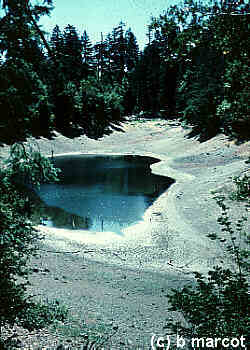
Here is a prime example of an astatic pond -- one that fluctuates seasonally more than 10 percent of its maximum depth, sometimes much more, as in this case.
This pond is Sucker Lake, which is perched on the spine of Hogback Ridge in Six Rivers National Forest of northwestern California. Sucker Lake indeed holds suckers -- a type of catfish. With some colleagues, I netted specimens and had them identified.
It may be surprising what else that astatic ponds can provide in terms of wildlife habitat -- not only fish but also breeding amphibians, watering sites for predators and carnivores, and in this pond, a breeding population of western pond turtles (Clemmys marmorata). In 1976 colleagues and I studied the turtle population in this pond; that report is available upon request.
So the lesson is that even if ponds appear rather sterile, or without obvious wildlife use, they can be enormously valuable as habitat to a wide array of species.